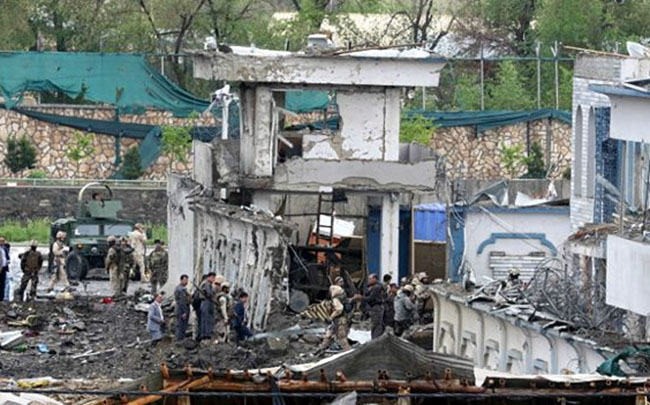These days Afghanistan is facing enormous challenges unprecedented in contemporary history of this country. Insecurity, joblessness, poverty, health issues and bad governance are the major frustrating concern. Social insecurity such as Robbery, kidnapping and explosions in all parts of the country including the capital has become a common practice.
Insecurity is a major and growing concern. Insurgent activity and military operations have undermined reconstruction efforts and restricted humanitarian interventions. In first years after the invasion of US-led international forces in 2001, there was a major inflow of refugees returning to their homes. The flow has gradually dwindled because of increasing insecurity, limited economic opportunities and limited access to basic social services. In 2015 with sixty-eight thousand refugees Afghanistan got the third place in the world!
Environmental degradation, especially in cities, is also a severe problem. Pollutions, uncontrolled grazing, pastureland encroachment, illegal logging and the loss of forest and grass cover have worsened drought conditions and reduced agricultural productivity.
The Average life expectancy estimated around 55 years, adult literacy stands around 28 percent, and millions of people are leaving the country due to joblessness and hopelessness. Thus millions are living in severe poverty with a crumbling infrastructure and a landscape that is suffering from environmental damage as well as pollution. Due to situating in a landlocked and strategic location it remains one of the poorest countries in the world, with more than half the population living below the poverty line. Most of them critically faced food-insecurity, which means they cannot get enough nutritious food to support an active, healthy lifestyle. Now the country suffers from one of the highest infant and maternal mortality rates in the world. Over half of children under 5 years are chronically malnourished (stunted) and about one-fourth of Afghan women of child-bearing age are underweight.
According to the findings, the National Risk and Vulnerability Assessment, 7.6 million people, roughly one-third of the population, are food-insecure, and a further 14 percent are considered to be borderline food-insecure. And owing to lack of awareness and ruling traditions, the households tend to be large. They include numerous children and several generations that share the same dwelling. Agriculture is traditionally the major activity for a large portion of the population, but the sector has suffered from nearly 30 years of conflict, low investments and natural disasters. The average size of landholding is small, and as a result agriculture is rarely the main source of food or income. About two thirds of rural households own some livestock, and farmers also sell their labor.
The incidence of poverty is more severe in rural areas. Approximately, seventy of percent central Afghanistan are poor and discriminated. The poorest rural people include small-scale farmers and herders, landless people, defenseless whom every year violated by Nomad, and women who is heads of households. There are an estimated more than 1 million Afghan widows. Their average age is 30 and 90 per cent of them have an average of four or more children. Without the protection of a husband, widows suffer from social exclusion in Afghanistan's patriarchal society. Many widows have no choice but to become beggars or hard labor. Children aged five or under are the most vulnerable segment of Afghan society, and as many as 50 per cent of them suffer from chronic malnutrition.
When we talk about Afghanistan or hear about it in the news, it can be very easy to forget that the insurgents are people and that a huge portion of them is suffering through extreme poverty. For the average Afghan, life can be very difficult and stricken with economic struggle, food insecurity, and a lack of resources to improve their lives. Here are a few facts that may come as a surprise about those living in poverty in Afghanistan.
Only 28.1% of the entire population over the age of 15 is literate, meaning that 71.9% of adults are incapable of even basic reading and writing skills. On average, those who are capable of going to school only complete about 8 years, with females generally completing 4 years less than their male counterparts.
An estimate of the percentage of children aged 5-14 suggests that at least 25% were involved in child labor. UNICEF made an estimate that the number had risen to at least 30%. In either case, around ¼ or more of all young kids in the country were being forced to work, therefore missing out on childhood and, most importantly, a proper education.
36% of the population, or about 9 million people, lives in absolute, extreme poverty and another 37% lives just above the determined poverty line. In fact, the number one killer in Afghanistan is not armed conflict but poverty.
Half of the population still lives without access to improved water sources, these accounts for both men and women living in rural and urban areas.
For every 100,000 births, 460 mothers die and for every 1,000 births, 119 infants die. This leaves Afghanistan with the second highest maternal mortality rate in the world and the third highest infant mortality rate. Many of these deaths would be preventable with trained doctors and expedient, affordable care. But, with less than 1 doctor per every 1000 people, 0.21 of a doctor to be precise, proper care is difficult to come by.
These challenges indicate that Afghanistan has begun returning to the past and losing the values and political achievements obtained with support of international community. What it needs to be notified that an unsecure Afghanistan is not only threat to Afghan but also a proper bed for growing international terrorism.
Home » Opinion » Suffering the Bitterest Days of Modern History
Suffering the Bitterest Days of Modern History
| Mohammad Zahir Akbari

